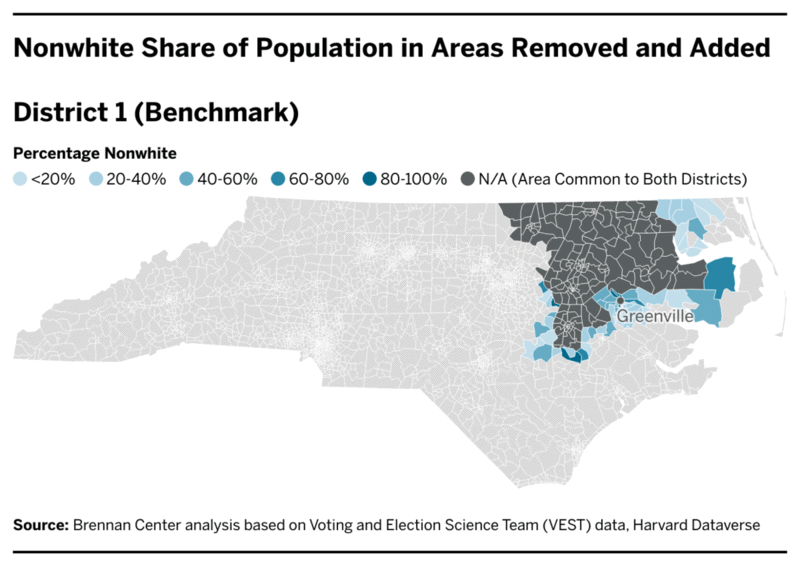When North Carolina redrew its legislative and congressional districts 10 years ago, the Voting Rights Act required that it — along with other states with a history of racial discrimination — submit their maps for review by the Justice Department or a federal court before putting them into effect, a process known as preclearance. The current round of redistricting is starkly different.
In 2013, the Supreme Court invalidated the formula in Section 5 of the Voting Rights Act that determined which states were subject to preclearance. In the years since that decision in Shelby County v. Holder, political gridlock in Congress has thwarted efforts to update the formula and bring the Voting Rights Act back to full strength. That failure has allowed North Carolina to enact some of the most discriminatory district maps in its history after the 2020 Census.
To fill the void left by an idle Section 5, civil rights and good government groups in North Carolina have rushed to court to challenge the maps. This ongoing litigation is a race against the clock as election deadlines loom. With the 2022 elections getting closer, it’s more urgent than ever that Congress pass the John R. Lewis Voting Rights Advancement Act to make sure communities of color have adequate protections.
Before Shelby County, the Section 5 preclearance process stopped discriminatory schemes that would diminish the political influence of communities of color, an effect known as retrogression. North Carolina’s new congressional map is a case in point for why pre-implementation scrutiny for discriminatory effects is needed.
North Carolina received an additional congressional seat after the 2020 Census due to rapid population growth among communities of color, which accounted for nearly 90 percent of the state’s overall gains. Nonetheless, rather than increase electoral opportunities for voters of color, the legislature eliminated a historically majority-minority seat currently held by Rep. G.K. Butterfield (D), a member of the Congressional Black Caucus. Butterfield criticized the enacted plan as “racially gerrymandered” in a speech announcing his retirement, stating that the map “will disadvantage African American communities.”
Under a full strength Voting Rights Act, this map would have undergone a retrogression inquiry. The DOJ would compare a covered jurisdiction’s proposed district scheme to an internal “benchmark” plan — generally, the last nondiscriminatory plan to have received preclearance or been drawn by a court, with adjustments made for demographic changes. If the analysis revealed that the new plan decreased electoral opportunities for voters of color, the DOJ would require revisions.
For North Carolina, the benchmark is the 2019 congressional map adopted by a state court to remedy a pro-Republican gerrymander that violated the state constitution. The newly adopted congressional map differs from that court-drawn benchmark plan in ways that will likely reduce the political influence of voters of color, even as their numbers have grown. In other words, a retrogression inquiry may well have stopped this discriminatory map from taking effect.
The new district configuration eliminates one of the state’s two majority-minority districts and packs nonwhite population into the other one. A third district that was close to being majority nonwhite now has fewer of people of color. The other districts largely see major population centers divided up in ways that do not follow community lines or natural geographic boundaries. Wake, Mecklenburg, and Guilford Counties, all home to sizeable communities of color, are each split across three separate districts under the new plan. And Forsyth and Guilford Counties are broken apart, suggesting an effort to diminish the influence of Black voters in and around the city of Greensboro, echoing maps from last decade that were found to violate the state constitution.
The chart below orders North Carolina’s congressional districts from highest percentage nonwhite voting age population (a stand-in for eligible voters) to lowest, and the arrow indicates how these percentages shifted from the benchmark to the enacted plan.
Focusing in on changes to the district that Butterfield currently holds reveals more specific evidence of retrogression. By removing Greenville and diverse areas in eastern North Carolina, GOP map drawers lowered the nonwhite voting-age population in the district from 52.4 percent to 49.4 percent — meaning the district’s eligible voters are now majority-white. The Black voting-age population alone decreases from around 41 percent in the old plan to roughly 38 percent under the new map, making it more difficult for Black voters to elect their preferred candidate. While much of the district stayed the same, over 62 percent of the voting-age people added to the district are white, while nearly half of those moved out of the district are nonwhite. These changes around the margins, as demonstrated by the map below, change both the overall composition of the district and its political lean.

As the graphic shows, map drawers carved out several majority-nonwhite areas from the eastern part of the benchmark district and pulled in majority-white areas such as Caswell and Person Counties. Politically, the once solidly-Democratic district becomes highly competitive under the new map. Before announcing his retirement, Butterfield was included on the National Republican Congressional Committee’s list of Democrats to target during the 2022 election cycle, underscoring how the map-drawing process in North Carolina is part of a broader effort to tip the political scales. Too often, these partisan objectives are achieved at the expense of fair representation for communities of color, particularly in the absence of federal oversight. With preclearance revived, these changes would be analyzed by experts to ensure that they do not decrease opportunities for voters of color.
Reinvigorated protections would also mean that the district including Charlotte — where minority voters were packed into a single district and Democrats outnumber Republicans by a three-to-one ratio — would receive close scrutiny. The same goes for the lines carving up Greensboro, a heavily Black city, across four separate districts each with nonwhite voting age populations of around 30 percent.
Such review would flag blatant backsliding and require legislatures to redraw maps found to be retrogressive. North Carolina’s new plan, as well as recent maps in Texas, Georgia, Alabama, and other states, demonstrate the need for this pre-implementation review so that voters of color are ensured a baseline of fairness and don’t have to rush litigation.
In her dissent in Shelby County, Justice Ruth Bader Ginsburg said that “throwing out preclearance when it has worked and is continuing to work to stop discriminatory changes is like throwing away your umbrella in a rainstorm because you are not getting wet.” She was right, and this redistricting cycle has unleashed a monsoon of maps that undercut the voting power of communities of color. Congress must meet this moment and restore critical protections by passing the John R. Lewis Voting Rights Advancement Act.




